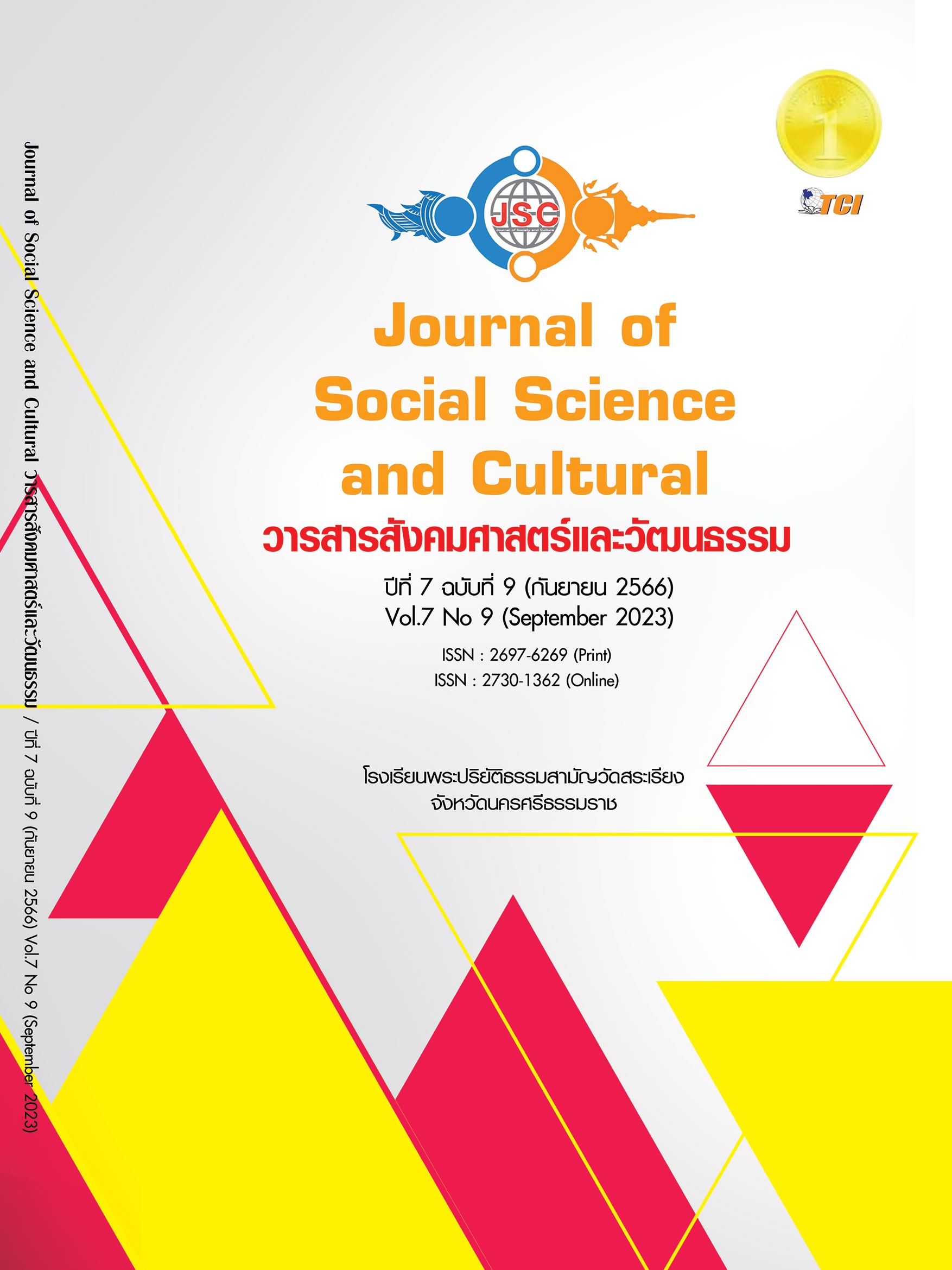DEVELOPMENT OF ACTIVITY MODELS TO ENCOURAGE THE HUMAN CAPITAL VALUE OF LIFE INSURANCE AGENTS IN THE DIGITAL ERA
Main Article Content
Abstract
The purpose of this study is 1) to study the present situation, problems and development need of activity models to encourage the human capital value of life insurance agents in the digital era 2) to development of activity models 3) to use activity models and 4) to evaluate the use of activity models. This research is a mixed method of both quantitative and qualitative research. The population is life insurance agents belonging to the top 5 life insurance companies with the highest market share in 2021, numbering 162,870 people. Simple sampling was done according to the proportion of each company, resulting in a sample size of 400 people and a target group of 30 people. For quantitative research, data were collected using a questionnaire. Data were analyzed using basic statistics. For qualitative research, data were collected using in-depth interviews, group discussions, brainstorming, model test and evaluated. Data were analyzed using content analysis and descriptive analysis. The results of this research found that 1) situation of activity models to encourage the human capital value of life insurance agents in the digital era 1.1) Overall, there are moderate activities. 1.2) Problems encountered include life insurance agents not seeing the importance of participating in activities. Lack of budget to support inviting speakers Activities are not consistent with needs. There is no systematic organization of activities. 1.3) Life insurance agents require the following activities: 3 aspects: Value-added Value diversity and Value creation. 2) After developing activity forms and criticisms, all activities 10 activities. 3) It took 4 months to use the activity models from March to June 2023 4) The evaluation is very satisfied with the relevant personnel, and the sales volume and life insurance policy have increased.
Article Details
References
กนกกาญจน์ สุประดิษฐ์. (2557). ปัจจัยที่มีความสัมพันธ์กับความสำเร็จของตัวแทนประกันชีวิตของบริษัทกรุงไทย-แอกซ่า ประกันชีวิต (มหาชน). ใน วิทยานิพนธ์บริหารธุรกิจมหาบัณฑิต สาขาวิชาการจัดการ. มหาวิทยาลัยศรีนครินทรวิโรฒ.
ฐิตพัฒน์ สตางค์จันทร์ และภัทรธิรา ผลงาม. (2560). การพัฒนากิจกรรมส่งเสริมการเรียนรู้ในศตวรรษที่ 21 ของนักเรียนโรงเรียนในสังกัดสำนักงานเขตพื้นที่การศึกษาประถมศึกษาเลย เขต 2. วารสารมหาวิทยาลัยศิลปากร สาขามนุษยศาสตร์ สังคมศาสตร์ และศิลปะ, 11(1), 343-365.
ณัฐนรี ดำรงเลาหพันธ์ และกรวรรณ กฤตวรกาญจน์. (2565). ปัจจัยด้านการสื่อสารเพื่อโน้มน้าวใจของตัวแทนขายประกันที่มีผลต่อการตัดสินใจซื้อประกันชีวิตของประชาชนในจังหวัดเชียงใหม่. วารสารการสื่อสารมวลชน คณะการสื่อสารมวลชน มหาวิทยาลัยเชียงใหม่, 10(2), 151-171.
ธิดารัตน์ เวชประสิทธิ์ และคณะ. (2565). แนวทางการพัฒนาทีมงานประกันชีวิต : กรณีศึกษาบริษัท XXX. วารสารวิทยาลัยสงฆ์นครลำปาง, 11(3), 18-26.
ปรียาภัทร์ สมใจ และคณะ. (2562). การพัฒนาสมรรถนะพนักงานขายโดยใช้โปรแกรมการฝึกอบรมผ่านทางสื่ออิเล็กทรอนิกส์บริษัทกลุ่มอุตสาหกรรมนมพาสเจอร์ไรส์. วารสารดุษฎีบัณฑิตทางสังคมศาสตร์, 9(1), 88-102.
พชร อารยะการกุล. (2563). Bluebik แนะธุรกิจประกันเร่งสร้างสรรค์นวัตกรรมในยุคดิจิทัลและสร้างระบบนิเวศทางธุรกิจ. เรียกใช้เมื่อ 25 สิงหาคม 2565 จาก https://www.mitihoon.com/2020/08/03/190604.
ราชวุธ ปัญญาวชิโร. (2561). การบริหารสถานศึกษาในยุคดิจิทัล ตามหลักสัปปุริสธรรม 7 โรงเรียนพระปริยัติธรรม แผนกสามัญศึกษา จังหวัดขอนแก่น. ใน วิทยานิพนธ์พุทธศาสตรมหาบัณฑิต สาขาวิชาพุทธบริหารการศึกษา. มหาวิทยาลัยมหาจุฬาลงกรณราชวิทยาลัย.
วัฒนลักษมิ์ เวชประสิทธิ์ และคณะ. (2562). แนวทางการพัฒนาสมรรถนะตัวแทนประกันชีวิต กรณีศึกษา สำนักงานตัวแทน บริษัท กรุงไทย-แอกซ่า ประกันชีวิต จำกัด (มหาชน) สาขานวลจันทร์ กรุงเทพมหานคร. วารสารพุทธนวัตกรรมและการจัดการ, 5(2), 92-106.
ศิริภรณ์ พุทธรักษ์ และคณะ. (2563). ผลสัมฤทธิ์ในการประกอบอาชีพตัวแทนประกันชีวิตในสังกัดสานักงานตัวแทน บริษัท เอไอเอ จำกัด. วารสารสหวิทยาการมนุษยศาสตร์และสังคมศาสตร์สถาบันรัชต์ภาคย์, 3(2), 221-234.
สมาคมประกันชีวิตไทย. (2565). รายงานสถิติธุรกิจประกันชีวิต. เรียกใช้เมื่อ 6 กรกฎาคม 2565 จาก https://www.tlaa.org.
สำนักงานคณะกรรมการกำกับและส่งเสริมการประกอบธุรกิจประกันภัย (คปภ.). (2556). บริษัทประกันชีวิต. เรียกใช้เมื่อ 4 สิงหาคม 2565 จาก https://www.oic.or.th/th/consumer.
สำนักงานส่งเสริมเศรษฐกิจดิจิทัล กระทรวงดิจิทัลเพื่อเศรษฐกิจและสังคม. (2565). แผนแม่บทการส่งเสริมเศรษฐกิจดิจิทัล ระยะที่ 2 ปี 2566-2570. เรียกใช้เมื่อ 16 สิงหาคม 2565 จาก https://www.depa. or.th/th/master-plan-digital-economy/master-plan-for-digital-economy-66-67.
สุดารัตน์ ธีรธรรมธาดา. (2557). ปัจจัยแรงจูงใจใฝ่สัมฤทธิ์ พฤติกรรมเชิงสร้างสรรค์ และความฉลาดทางอารมณ์ที่ส่งผลต่อประสิทธิภาพในการทำงานของพนักงานบริษัทเอกชนในเขตกรุงเทพมหานคร. ใน วิทยานิพนธ์ธุรกิจมหาบัณฑิต สาขาวิชาการจัดการ. มหาวิทยาลัยกรุงเทพ.
สุทธิพล ทวีชัยการ. (2561). คปภ. เน้นพัฒนาคนกลางประกันภัยในเชิงคุณภาพ ติวเข้มผ่าน “โครงการเพิ่มศักยภาพวิทยากรหลักสูตรตัวแทน/นายหน้าประกันภัย”. เรียกใช้เมื่อ 12 ตุลาคม 2565 จาก https://gnews.apps.go.th.
Barney, Jay B. (1991). Firm resources & sustained competitive advantage. Journal of Management, 17(1), 99-120.
Burns, N., & Grove, S.K. . (2005). The Practice of Nursing Research: Conduct, Critique and Utilization. (5th Edition). Missouri: Elsevier Saunders.
Hsieh, S., et al . (2012). Analysis on literature review of comlietency. Exhibition literature and analysis. International Business Dand Economic, 2(2012), 25-50.
Huse, E. F., & Cummings, T. G. (1985). Organization Development and Change. New York: West Publishing Company.
John w. Best. (1995). Research in Education. Prentice-Hall: New Dalhi.
Yamane, T. (1973). Statistics: An Introductory Analysis. (3rd Ed). New York: Harper and Row Publications.


